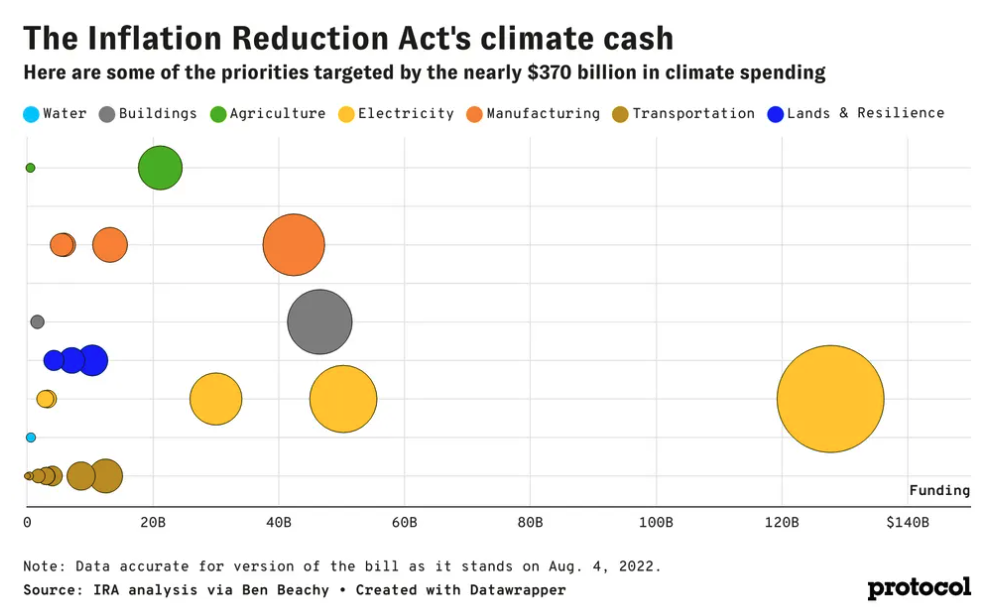How the IRA Invests in Carbon Capture
On Aug 16, 2022, President Joe Biden signed the Inflation Reduction Act (IRA) into law. This marks an important step forward in how the US is handling the issue of climate change now and for years to come.
Where the money goes
Graphic by: Protocol
The Inflation Reduction Act is spending 430 billion dollars to reduce the country’s carbon emissions, extend the Affordable Care Act, and help the western states prepare for drought. 369 billion of that is going to energy security and climate change. This money is divided up between a long list of specific investments to help slow climate change.
The largest chunk of money is going to things like making renewable energy cheaper and incentivizing sourcing parts and materials from America. This will push more people to have a reason to switch from fossil fuels to renewables because more people will be able to afford it. Not only that, but sourcing parts and materials from America will create more jobs and, with wage requirements also set by the IRA, more people will have the disposable income to make that switch.
A lot of homes in the US currently rely on gas powered heating and cooking systems, and buying and installing their electric counterparts can be expensive. The Inflation Reduction Act sets aside money specifically to help homeowners with these expenses. This includes electric vehicle tax credits to incentivize people to make their next car purchase an electric one.
With these things in place, as well as all of the others, experts are predicting/protecting that America will produce 40% less CO2 than it did in 2005. With very little legislation put into place to protect our planet until now, this is extremely exciting. Even with this big win for the planet, it’s important to remember that things like this don’t often come without compromise; and the Inflation Reduction Act is no exception.
Carbon Compromise
One of the biggest compromises was a result of needing West Virginia Senator Joe Manchin’s support to get the bill past the Senate. With Manchin’s support of the bill, the vote would be 50/50 split evenly down party lines with Vice President Kamala Harris as the tie breaking vote.
In obtaining Sen. Manchin’s vote, Manchin successfully negotiated the availability of oil and gas leases in Alaska and the Gulf of Mexico as well as preventing the ban of fossil fuel leases on federal land for the next ten years and guaranteeing subsidies for new pipelines. He also ensured that there would be investments specifically for carbon capture.
This last one seems a little out of place at first glance. Carbon capture is the process of removing a harmful compound from the environment, while all of Sen. Manchin’s other demands do the exact opposite.
To understand why he negotiated for this particular issue, it’s first important to understand what the majority of carbon capture looks like right now, and where it takes place.
Types of Carbon
The carbon capture that is most being used currently is industrial carbon capture. It involves huge amounts of energy, long pipelines, and is used at highly polluting industrial plants. This type of carbon capture essentially filters smokestacks and pumps the carbon out to store underground somewhere.
So it’s not perfect, but it’s making industrial processes cleaner. Why is that a bad thing?
Industrial carbon capture itself isn’t what people are objecting to. The worry here is that industrial carbon capture is not a solution to the pollution, it’s a temporary patch. But more importantly, the more money being invested into industrial carbon capture, the more likelihood that fossil fuels will stick around longer. Protesters of this issue see this as money that could be invested in renewable energy being invested instead in propping up fossil fuels.
While industrial carbon capture can be controversial, it is imperative that everything possible is done to reduce carbon emissions now, while the transition to renewables is taking place. Additionally, carbon capture from power plants is not the only type of carbon capture the IRA can fund. Companies like Carbon Reform reside in the category of carbon capture that doesn’t have the caveat of indirectly supporting the use of fossil fuels or high level polluting industrial processes.
At Carbon Reform, we’re focusing on using carbon capture technology to remove CO2 from everyday processes and in everyday spaces. And while industrial carbon capture is storing the CO2 deep in the earth, Carbon Reform is turning that CO2 into a useful, carbon-negative product. As Carbon Reform and non-industrial carbon capture start to become more popular and are able to receive this funding, the air that people breathe will get cleaner. And thanks to the IRA, building owners installing carbon capsules will be able to generate more carbon removal credits than before, incentivizing more and more people to follow their lead.




